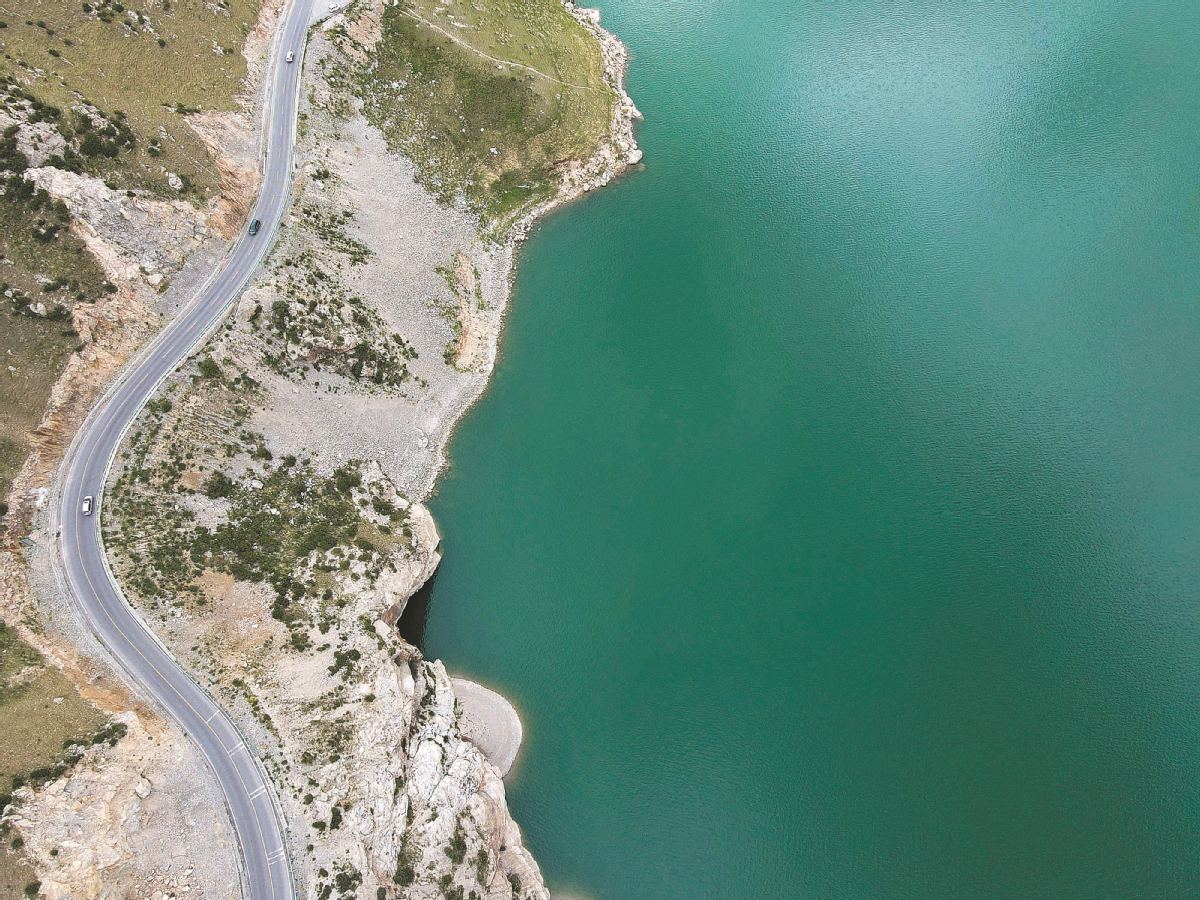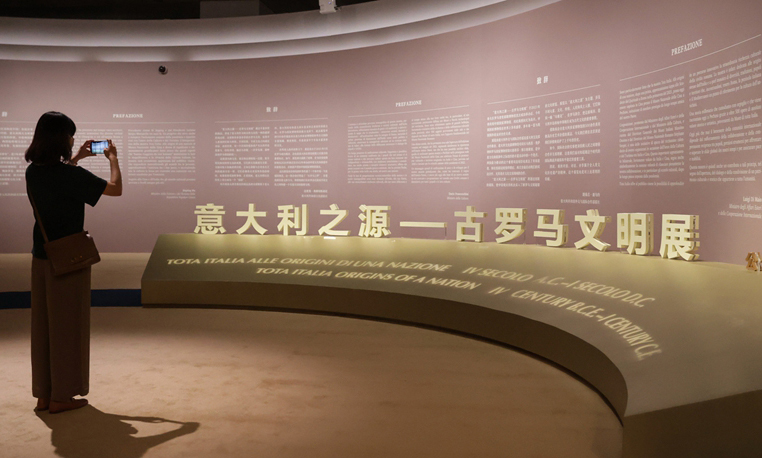Visitors fall for Xinjiang's scenic splendors

The 561-kilometer-long Dushanzi-Kuqa Highway wends its way through the Tianshan Mountains in Xinjiang Uygur autonomous region, connecting Dushanzi in the north with Kuqa in the south. GAO HAN/XINHUA
Mountain highway enables tourists to experience region's ethnic groups, religions and cultures
Viewing the beauties of the four seasons in a single day amid diversified landforms ranging from snow-capped mountains to lakes, grasslands, deserts and fields of flowers is an amazing experience.
These attractions draw visitors to one of China's most beautiful roads, the 561-kilometer-long Dushanzi-Kuqa Highway, which wends its way through the Tianshan Mountains in the Xinjiang Uygur autonomous region, connecting Dushanzi in the north with Kuqa in the south.
The highway is only open to traffic from June to early October, being closed throughout the winter and spring due to snowfalls and an icy road surface. Vehicles with more than seven seats are not allowed on the highway because of its sharp turns and steep slopes.
Short-video footage taken by visitors that has gone viral in recent years has attracted increasing numbers of tourists to explore the highway's scenic delights.
This year, the local authorities prepared for the highway to open by upgrading infrastructure and launching a range of activities to welcome arrivals from across the country. COVID-19 preventive measures have also been relaxed.
Gong Jiansheng, who is in charge of the Bairui Travel Agency in Urumqi, the region's capital, said, "There is a great deal to see in Xinjiang, but it is such a vast area that it is worth visiting several times to witness the stunning scenery."
The agency, which is owned by China Tourism Group, offers customized trips. A guide takes visitors to the homes of ethnic groups such as Uygurs and Kazaks, where they dine with the locals and help graze their livestock.
While traditional travel agencies often provide five-day tours starting from Urumqi, Gong suggests that visitors with plenty of time spend at least a week in Xinjiang.
He reminds arrivals that sometimes the narrow highway is congested during the peak tourist season.
Gong also suggests that travelers prepare well for their trip before departure, bringing with them food and warm clothing to keep out the cold.
Over 280 kms of the highway are located at an altitude of more than 2,000 meters.
In recent years, the local government has made every effort to upgrade infrastructure and repair the road. More public toilets have been provided, along with garbage disposal areas. Locations have also been established for visitors to take photos.
Gong, who has great confidence in Xinjiang's tourism industry, said: "It's now more convenient for visitors to come to the region. The travel experience has been significantly advanced, and I hope there will be more improvements."
Min Xiaoli, a tour guide from Urumqi, said, "The most striking aspect of the highway is the unique scenery, which suddenly changes as you go through the mountains."
She said the region attracts visitors of all ages, including some in their 60s and 70s who want to fulfill their dream of traveling on the highway after retirement. While many younger visitors drive themselves, middle-aged and elderly arrivals tend to opt for group tours.
"Xinjiang is a destination that offers a comprehensive travel experience, with its ethnic groups, religions and different cultures. Visitors really need to experience these cultures, rather than merely take in the beautiful scenery," Min said.
She added that COVID-19 prevention and control policies in Xinjiang have relaxed greatly compared with last year, and all such measures in the region are now being carried out in "a more scientific and precise way".
Min said that due to sporadic outbreaks of COVID-19 in some big Chinese cities, which are the major source markets for visitors to Xinjiang, other policies are also aimed at encouraging locals to tour the region.

Visitors ride camels by Sayram Lake in Bortala Mongolian autonomous prefecture, Xinjiang. CHINA DAILY
Road to prosperity
The popularity of the Dushanzi-Kuqa Highway has enabled locals to earn a good living by joining the tourism industry.
For example, Beishan, the first village in Kuqa that tourists pass through when they enter southern Xinjiang, has witnessed far-reaching changes over the past year.
In June last year, the village committee invested more than 10 million yuan ($1.50 million) in renovating the area and upgrading infrastructure to attract tourists.
The committee invited outside investment and used the village collective's funds to develop the tourism industry from scratch.
Thanks to this booming industry, the collective's income rose to about 350,000 yuan last year, up from 40,000 yuan in 2020.
Some villagers who used to make a living by grazing goats and sheep, or who worked in nearby cities, have opened homestays in Beishan.
Visitors pose for photos in front of the village's colorful murals, which boast themes ranging from ethnic group culture to rural vitalization. These artworks were created in just three months by teachers and students from the Central Academy of Fine Arts in Beijing.
To cater to tourists, the village has set up a caravan campsite, a horse-riding venue, minsu (Chinese-style bed-and-breakfast establishments) and activities centered on agritainment-entertainment in an agricultural setting. In well-designed minsu, tourists can lie on their beds and view the starry night sky through skylights.
Villagers also organize bonfire parties and folk activities to welcome tourists.
Shi Yaowen, the Beishan Party secretary, said: "Tourists like our village because of its primitive nature and non-commercial atmosphere. All the residents are locals, and visitors can observe the villagers' daily lives and experience the ethnic culture."
Early this month, more than 100 vehicles arrived in Beishan from outside the area every day, with some visitors opting to stay overnight.
Shi said efforts are being made to build the village as a brand aimed at the mid- to high-end market.
In the first half of this year, more than 2 million tourist visits were reported in Kuqa city, bringing in revenue of nearly 1.08 billion yuan.
Suo Shanwu, director of Kuqa's bureau of culture, sports, radio, television and tourism, said the city's tourism industry has been boosted greatly by the Dushanzi-Kuqa Highway.
Kuqa's scenic areas, including the Mysterious Grand Canyon of Tianshan Mountains, have attracted floods of visitors recently, with the city's starred hotels reporting full occupancy.
Suo said the local authorities have invited entrepreneurs nationwide to conduct research on business cooperation programs.
Kuqa, known as Qiuci in ancient times, was an important kingdom on the ancient Silk Road, and promoting the Qiuci culture among tourists is important for the city to attract arrivals.

Visitors stop at a scenic spot along the highway. GAO HAN/XINHUA
Exotic culture
Zhang Xiaoyu, secretary-general of the Xinjiang Tourism Association, said, "The region's unique landforms and exotic culture make it stand out among its counterparts, especially with outbound travel suspended in China due to COVID-19."
He said one of the problems in developing tourism in Xinjiang is that the region is a long way from cities such as Beijing, from which it takes as long as four hours to reach Urumqi by air.
"In some sparsely populated areas, drivers and their passengers commonly see nobody else when they travel for several hundred kilometers. Xinjiang's tourism infrastructure has improved greatly, but more investment is still needed to improve service quality," Zhang said.
Wu Liyun, an associate professor at the China Academy of Culture and Tourism at Beijing International Studies University, said, "As tourists are drawn to popular attractions, it's important for management to understand visitors' requirements in order to maintain a good reputation."
She suggested that to help tourists, local authorities draw up plans for infrastructure and public services-for example, by deciding where to put up sign boards, build gas stations and establish parking lots.
"In-depth tourism products and good-quality services are paramount," Wu said.
She added that as well as driving along the highway and enjoying the scenery, visitors would prolong their stay when they are attracted by local scenic areas, cultural activities and accommodations. It is also important to give related information to tourists and enhance support services.
"Travel experiences can connect the tourism and folk resources along the highway, boosting the local tourism industry," Wu said.
She also believes it is vital to provide visitors with real-time information about the highway, including news of weather, traffic and road conditions, so that they can plan their trips efficiently.
Wu also suggested that the authorities send such information to those on the highway via text messages or mobile apps.
"To enrich visitors' travel experience, caravan campsites should provide eye-catching activities, along with dining services and recreational infrastructure," she added.
Photos
Related Stories
- Young craftsman of musical instruments passes on traditional musical culture of Xinjiang
- Modern agricultural technology, machinery applied in Urumqi to help farmers increase yield
- Young female inheritor of tightrope walking shows pizzazz in pursuit of artform in NW China’s Xinjiang
- Corban Festival celebrated in China's Xinjiang
- Natural scenery of Bayanbulak grasslands in Xinjiang
Copyright © 2022 People's Daily Online. All Rights Reserved.









